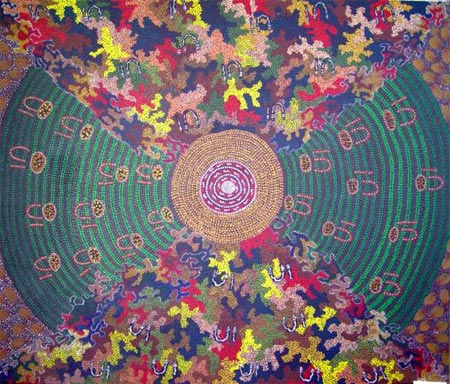Peter Leo Tjakamarra
Region: Laramba, Northern Territory,Australia
Language Group: Anamatyerre
Born: 1950, Dec 2004
Peter Leo Tjakamarra was born on Coniston Station; his traditional country is Anuka (Coniston) and the area around Tilmouth Well, which is situated on Napperby Station.
He commenced painting in 1986 as part of the Napperby group of painters.
He painted Witchetty Grub, Hunting, Yam, Snake Dreaming, Seven Sisters Dreaming and also painted works depicting the Coniston Station Massacre.
The Wichetty Grub is a large white wood eating larvae of several types of moth. They are used as a food by the Aboriginals of Central Australia they can be eaten raw or cooked in the ashes of a fire.
)He was married to Susan Dixon Leo Napaltjarri who also paints and often worked with Peter.
His works have been exhibited in most Major Australian cities and the U.S.A. (Aboriginal Artists Dictionary of Biographies)
Peter Leo Tjakamarra And The Coniston Station Massacre
The Massacre occurred between August and October in 1928.
It was the last known massacre of Aboriginals in Australia.
It involved men women and children of the Warlpiri, Anmattyre, Kayete, tribes.
At least thirty-one people were killed but it is thought up to a hundred or more may have perished.
The massacre occurred to avenge the killing of a Dingo (wild dog) hunter named Fredrick Brooks by the Aboriginals.
In 1928 there had been a drought and waterholes were drying up bush food and wild life was becoming scarce.
The permanent water holes were on the stations these stations were on what had once been the Aboriginals land.
The Aboriginals were going onto these stations begging for food and water and spearing cattle to eat.
There are several accounts of what led to the killing of Frederick Brooks one of the alleged accounts has him camped at one of the water holes and a group of Aboriginals were also camped nearby.
Brooks offered food to the wife of one of the men “Bullfrog” in return for her doing his washing.
Brooks not only did not pay for the food but Bullfrog found his wife in bed with Brooks and he, his wife and his uncles beat Brooks to death and disposed of the body in a rabbit hole.
Soon after the reports of Brooks death and the discovery of the body over a period of months a number of reprisal attacks were carried out on various groups of Aboriginals these attacks are collectively called the Coniston Massacre.Two Aboriginal men were arrested but were acquitted due to a lack of credible evidence.
An enquiry was held into the massacre but no charges were made and none of the people involved in the massacre were brought to justice despite the Australian public's outrage.
In traditional Aboriginal law Bullfrog would have been regarded as having acted lawfully within his marriage rights to kill the man who had taken his wife.
The tragic events of the massacre remain in Aboriginal History and are commemorated in Peter Leos art works.


© Copyright 2010 All Rights Reserved No Reproduction Permitted Without Permission
Address : Michael Moriarty, PO Box 14, Berry Springs, NT, 0838, Australia